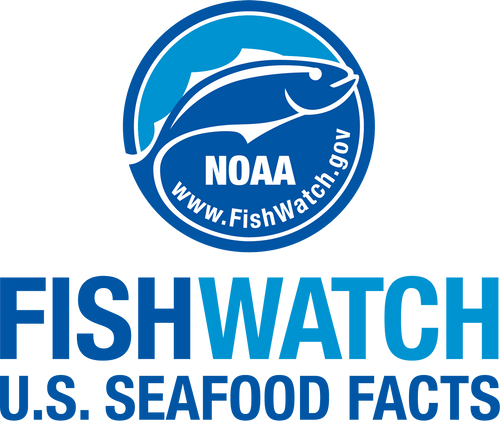 California market squid. Credit: NOAA Fisheries
California market squid. Credit: NOAA Fisheries
California market squid. Credit: NOAA Fisheries
About the Species
 California market squid. Credit: NOAA Fisheries
California market squid. Credit: NOAA Fisheries
California market squid. Credit: NOAA Fisheries
U.S. wild-caught California market squid is a smart seafood choice because it is sustainably managed and responsibly harvested under U.S. regulations.

Population
Population level is unknown, but management measures are in place.

Fishing Rate
Overfishing status is unknown, but management measures are in place.

Habitat Impact
Pelagic gear used to catch market squid has minimal impact on bottom habitat.

Bycatch
Bycatch is low because pelagic roundhaul gear is selective.
Population Status
- Short- and long-term changes in the market squid population are poorly understood, The stock has not been assessed so there are no reliable estimates of the population size and the overfished and overfishing status are unknown.
- Squid have a short life span (6 to 9 months) and fishermen target spawning squid because they die shortly after they reproduce.
- Even without fishing, the entire population replaces itself annually. As a result, market squid populations can handle a relatively high amount of fishing pressure.
- Ensuring that fishermen capture squid that have already spawned is key to the production of the next generation and future health of the population.
- The overfishing status is unknown.
Appearance
- Market squid are members of the mollusk family known as cephalopods, which means foot-on-head.
- They have eight arms and two tentacles that extend from the ends of their bodies where their mouths are located.
- They have a mixed, iridescent coloration of milky white and purple, but their coloring can change in response to environmental conditions.
Biology
- Market squid are fast-growing animals with a short natural life span. They reach up to 1 foot in total length, including their arms.
- They reproduce right before they die, around the age of 1 year.
- They spawn year-round. Spawning occurs April through October in central California and October through the end of April or May in southern California.
- Spawning squid congregate in large schools near their spawning grounds, usually over sandy habitats.
- Males deposit spermatophores into females, and the eggs are fertilized as females release them. Females produce about 20 egg cases, with each case containing about 200 individual eggs.
- Females deposit eggs on sandy habitats, building large mounds of egg cases. Eggs take several days to months to hatch, depending on temperature.
- Newly hatched eggs are called “paralarvae” and resemble miniature adults.
- Juvenile market squid feed on small crustaceans. As they grow, they feed on krill, small crustaceans, small fish, and other squid.
- Market squid are a critical food source for a variety of fish (salmon, lingcod, and rockfish), seabirds, and marine mammals.
Where They Live
Range
- Market squid are found from the tip of Baja California to southeastern Alaska, but are most abundant between Punta Eugenia in Baja California and Monterey Bay, California.
Habitat
- Market squid live in the water column from the surface to depths of 2,600 feet.
- They prefer the salty ocean and are rarely found in estuaries, bays, or river mouths.
Fishery Management
- NOAA Fisheries, the Pacific Fishery Management Council and the California Department of Fish and Wildlife manage the market squid fishery in California.
- In California, the California Fish and Game Commission works with the California Department of Fish and Wildlife to actively manage the fishery consistent with federal fishery management guidelines and the State of California’s Market Squid Fishery Management Plan:
- Seasonal catch limits.
- Monitoring programs designed to evaluate the impact of the fishery on the resource.
- Time and seasonal closures, including weekend closures (that provide for periods of uninterrupted spawning), and limitations on using lights to attract squid around several of the Channel Islands to protect nesting seabirds.
- Permit system limits access to the fishery.
- The California Department of Fish and Wildlife and NOAA Fisheries also cooperatively monitor the fishery to evaluate its impact on the resource.
Harvest
- In 2022, commercial landings of market squid totaled 147 million pounds and were valued at $88 million, according to the NOAA Fisheries commercial fishing landings database.
- Purse seines and scoop nets are used to harvest market squid.
- Habitat and bycatch impacts are minimal because the gear is used at the surface around dense schools of fish, which usually contain only one species.
- Fishermen usually fish for market squid at night directly above the spawning grounds where females lay their eggs.
- Squid seiners typically work with light boats—smaller vessels with several high-powered lights pointed from various angles. The lights attract groups of spawning squid to surface waters.
- Once a group of squid comes to the surface, the light boat signals the seiner to deploy its net, encircling the light boat, in order to catch the squid located under the lights.
- California market squid are an important source of bait for the state’s recreational fishing industry.
Scientific Classification
- Market squid are found from the tip of Baja California to southeastern Alaska, but are most abundant between Punta Eugenia in Baja California and Monterey Bay, California.
- Market squid live in the water column from the surface to depths of 2,600 feet.
- They prefer the salty ocean and are rarely found in estuaries, bays, or river mouths.
Fishery Management
- NOAA Fisheries, the Pacific Fishery Management Council and the California Department of Fish and Wildlife manage the market squid fishery in California.
- In California, the California Fish and Game Commission works with the California Department of Fish and Wildlife to actively manage the fishery consistent with federal fishery management guidelines and the State of California’s Market Squid Fishery Management Plan:
- Seasonal catch limits.
- Monitoring programs designed to evaluate the impact of the fishery on the resource.
- Time and seasonal closures, including weekend closures (that provide for periods of uninterrupted spawning), and limitations on using lights to attract squid around several of the Channel Islands to protect nesting seabirds.
- Permit system limits access to the fishery.
- The California Department of Fish and Wildlife and NOAA Fisheries also cooperatively monitor the fishery to evaluate its impact on the resource.
Harvest
- In 2022, commercial landings of market squid totaled 147 million pounds and were valued at $88 million, according to the NOAA Fisheries commercial fishing landings database.
- Purse seines and scoop nets are used to harvest market squid.
- Habitat and bycatch impacts are minimal because the gear is used at the surface around dense schools of fish, which usually contain only one species.
- Fishermen usually fish for market squid at night directly above the spawning grounds where females lay their eggs.
- Squid seiners typically work with light boats—smaller vessels with several high-powered lights pointed from various angles. The lights attract groups of spawning squid to surface waters.
- Once a group of squid comes to the surface, the light boat signals the seiner to deploy its net, encircling the light boat, in order to catch the squid located under the lights.
- California market squid are an important source of bait for the state’s recreational fishing industry.
Scientific Classification
| Kingdom | Animalia | Phylum | Mollusca | Class | Cephalopoda | Order | Myopsida | Family | Loliginidae | Genus | Doryteuthis | Species | opalescens |
|---|
Last updated by NOAA Fisheries on 09/06/2024
Featured News
 Market squid at NOAA Fisheries Little Port Walter Research Station, Southeast Alaska. Credit: NOAA Fisheries/John Eiler
Market squid at NOAA Fisheries Little Port Walter Research Station, Southeast Alaska. Credit: NOAA Fisheries/John Eiler
Seafood Facts

Is California Market Squid Sustainable?
U.S. wild-caught California market squid is a smart seafood choice because it is sustainably managed and responsibly harvested under U.S. regulations.
Availability
Year-round.
Source
U.S. wild-caught from California.
Taste
Mild, and subtly sweet.
Texture
Cooked squid is firm.
Color
Raw squid should be moist, shiny, and ivory colored. Pink, yellow, or purple flesh indicates deterioration. Cooked squid is opaque white.
Health Benefits
Squid are an excellent source of selenium, riboflavin, and vitamin B12.
Nutrition Facts
Servings: 1; Serving Weight: 100 g (raw); Calories: 92; Protein: 15.58 g; Total Fat: 1.38 g; Total Saturated Fatty Acids: 0.358 g; Carbohydrate: 3.08 g; Total Sugars: 0 g; Total Dietary Fiber: 0 g; Cholesterol: 233 mg; Selenium: 44.8 mcg; Sodium: 44 mgMore Information
Last updated by NOAA Fisheries on 09/06/2024
Seafood News
 A signboard thanking patrons at Tuna Harbor Dockside Market in San Diego. Credit: Tuna Harbor Dockside Market.
A signboard thanking patrons at Tuna Harbor Dockside Market in San Diego. Credit: Tuna Harbor Dockside Market.
 Credit: NOAA Fisheries/Brianna Shaughnessy
Credit: NOAA Fisheries/Brianna Shaughnessy
 An oyster reef with lush greenery in the background. Credit: Adobe Stock
An oyster reef with lush greenery in the background. Credit: Adobe Stock
Documents
Proceedings of the 22nd Annual Trinational Sardine & Small Pelagics Forum Virtual Event - May 2, 2022
Proceedings of the virtual 22nd Annual Trinational Sardine and Small Pelagics Forum (TSF), hosted…
Proceedings Of The 2021 Trinational Sardine & Small Pelagics Forum (PDF, 37 pages)
Proceedings of the virtual 21st Annual Trinational Sardine and Small Pelagics Forum (TSF), hosted…
Proceedings of the 2019 Trinational Sardine & Small Pelagics Forum
Proceedings of the 20th Annual Trinational Sardine and Small Pelagics Forum (TSF) held on December…
Research
Trinational Sardine and Small Pelagics Forum
The Trinational Sardine and Small Pelagics Forum comprises sectors of government, academia, and industry from Mexico, Canada, and the United States to collaborate in improving coast-wide stock assessments.
Fisheries Oceanography in the California Current
The Fisheries Oceanography Program, composed with the Ichthyoplankton Ecology and Ship Operations groups, work to contribute to the understanding of the effects of climate change and climate variability on pelagic fisheries, with a primary focus on the…
Last updated by NOAA Fisheries on 09/06/2024



